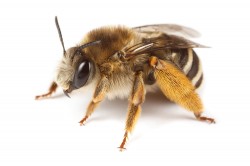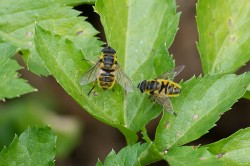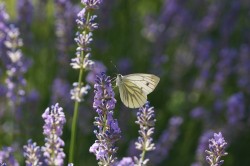Press Release, 21. March 2022
Survey of pollinators
The SPRING project is helping to establish an EU-wide monitoring system for pollinators
Insects have an important function for both ecosystems and the economy. Almost 90% of flowering wild plants worldwide depend at least partially on pollination by animals. More than 75% of all food crops also need pollinators if they are to produce high yield and good quality. But what about these important helpers? Where are their populations threatened? And what can be done about it? So far, there has been a lack of systematic inventories in Europe that can provide answers to these questions. A new EU-funded project called SPRING (Strengthening Pollinator Recovery through Indicators and monitoring) now aims to remedy the situation. An international research team of 19 partners coordinated by the Helmholtz Centre for Environmental Research (UFZ) and the UK Centre for Ecology and Hydrology (UKCEH) is working on an EU-wide census of pollinators.

Photo: Nicolas Vereecken / Selections Naturelles

Photo: Rui Felix

Photo: Ulrike Schäfer
Apart from honey bees and perhaps a few butterflies, there are very few insects with "celebrity status". Even though many species play an important role as pollinators, they have largely flown under the radar of public awareness. However, in the meantime, societal and political interest in these animals has increased considerably. Without these species, there would be massive damage to both ecosystems and the economy. In the face of this, scientists have called for robust monitoring of Europe’s pollinators. In response, the EU Pollinators Initiative has committed to develop an EU-wide pollinator monitoring scheme to ensure the provision of good quality data for assessing the status and trends of pollinator species in the EU.
"Most parties agree that we need better indicators for the state of biodiversity in Europe", says UFZ biodiversity researcher Prof. Josef Settele. Further, what about the biodiversity trends in different regions? Are there already ongoing losses that could lead to serious problems for food production and biodiversity conservation? So far, this can be seen in only a few, well-studied groups of plants and animals such as birds or butterflies. But this previously incomplete picture will come into focus, as SPRING helps establish an EU-wide census of pollinators.
The concept for an EU Pollinator Monitoring Scheme was developed and published by an international group of experts in 2020, under the coordination of the Commission’s Joint Research Centre. The SPRING project, which has a budget of €5 million, will carry out part of this census by 2023. Nineteen research institutions will be involved in the project, which is coordinated by Prof. Josef Settele from the UFZ and Dr David Roy from the UK Centre for Ecology & Hydrology in Wallingford, UK.
"We will use the butterfly monitoring that already exists in many European countries as a blueprint for surveying pollinators", explains Settele. For Germany, the UFZ launched this Citizen Science project in 2005 together with the Gesellschaft für Schmetterlingsschutz e.V. (GfS). Since then, volunteers have been walking fixed routes in the summer months, counting the different species and numbers of butterflies spotted. The same principle is used to survey butterfly occurrences every year in numerous other countries in Europe.
However, Denmark, Greece, Latvia, Lithuania, Romania, and Slovakia still do not have such a programme. This will change within the framework of SPRING. Together with local nature conservation organisations, the project team will first look for volunteers and coordinators for the individual countries and then develop new, or translate existing, identification aids for the species found there. From this spring onwards, the butterfly hunt can really get underway.
However, Europe’s flowers are by no means pollinated only by butterflies; other groups of insects, such as bees and hoverflies, actually play a much greater role in this respect. So which insects must be recorded as a minimum in order to obtain meaningful data on the situation of pollinators? Which methods are suitable for this? What is the minimum area that needs to be examined? And what will the entire project cost? "In order to better assess all this, we will develop and test a foundation programme for meaningful monitoring as part of the project", says David Roy.
In up to 24 test areas per country, project staff will use a variety of standard methods to assess the diversity and abundance of pollinators. Similar to butterfly monitoring, volunteers will also count wild bees and hoverflies on defined routes. In tandem, the diversity of pollinators will be assessed using various insect traps. "Based on our experiences, we will develop recommendations on how the individual countries can best continue their monitoring", explains the UKCEH researcher.
However, in order to make all this work, the pollinator census needs enough qualified supporters. "Anyone who knows of initiatives that are already involved in recording pollinating insects is welcome to contact us", says Settele. Based on his experiences with butterfly monitoring, he is optimistic that amateurs can learn to distinguish some of the species with some basic training and a little practice. However, for other pollinating insect species this is much more challenging. For instance, in Germany alone there are around 560 species of wild bees, including bumblebees, and just a handful of people can confidently identify most of these species. In order to change this, the project team will offer online materials and training courses on bee and hoverfly identification. There are also plans for an app that can assign the correct name to some of the insects via image recognition.
In addition to expanding butterfly monitoring and testing the core programme, SPRING also has a number of other approaches being tested. For example, the Netherlands has started an initiative that will use a combination of simple traps and sophisticated image recognition technology to track moths. "We also want to test this in Germany with the active participation of the public", says Settele. "Our Dutch neighbours have already had good initial experiences with this".
After completion of the SPRING project, Europe will then for the first time have the ability to gain a full overview of the status of its pollinating heroes. "We hope that we can persuade most European states to carry out such monitoring", says Settele. "This is the only way we can start to assess where we are doing well in terms of pollinator protection and where we need to work harder".
Further information: www.spring-pollination.eu
Further information
Dr. David Roy
UK Centre for Ecology & Hydrology (UKCEH)
dbr@ceh.ac.uk
Prof. Dr. Josef Settele
Head of the UFZ Department of Conservation Biology & Social-Ecological Systems
josef.settele@ufz.de
UFZ press office
Susanne Hufe
Phone: +49 341 6025-1630
presse@ufz.de
In the Helmholtz Centre for Environmental Research (UFZ), scientists conduct research into the causes and consequences of far-reaching environmental changes. Their areas of study cover water resources, ecosystems of the future, environmental technologies and biotechnologies, the effects of chemicals in the environment, modelling and social-scientific issues. The UFZ employs more than 1,100 staff at its sites in Leipzig, Halle and Magdeburg. It is funded by the Federal Government, Saxony and Saxony-Anhalt.
www.ufz.deThe Helmholtz Association contributes to solving major challenges facing society, science and the economy with top scientific achievements in six research fields: Energy; Earth and Environment; Health; Key Technologies; Matter; and Aeronautics, Space and Transport. With some 39,000 employees in 19 research centres, the Helmholtz Association is Germany’s largest scientific organisation.
www.helmholtz.de